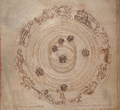Planet symbols
A planet symbol (or planetary symbol) is a graphical symbol used in astrology and astronomy to represent a classical planet (including the Sun and the Moon) or one of the eight modern planets. The symbols are also used in alchemy to represent the metals that are associated with the planets. The use of these symbols is based in ancient Greco-Roman astronomy, although their current shapes are a development of the 16th century.
The classical planets with their symbols and associated metals are:
| planet | Moon | Mercury | Venus | Sun | Mars | Jupiter | Saturn |
| symbol | ☾ | ☿ | ♀ | ☉ | ♂ | ♃ | ♄ |
| metal | silver | mercury | copper | gold | iron | tin | lead |
The International Astronomical Union (IAU) discourages the use of these symbols in modern journal articles, and their style manual proposes one- and two-letter abbreviations for the names of the planets for cases where planetary symbols might be used, such as in the headings of tables.[1] The modern planets with their traditional symbols and IAU abbreviations are:
| planet | Mercury | Venus | Earth | Mars | Jupiter | Saturn | Uranus | Neptune |
| symbol | ☿ | ♀ | ♁ | ♂ | ♃ | ♄ | ⛢ | ♆ |
| IAU | Me | V | E | Ma | J | S | U | N |
The symbols of Venus and Mars are also used to represent female and male in biology following a convention introduced by Carl Linnaeus in the 1750s.
History[]
Classical planets[]
The written symbols for Mercury, Venus, Jupiter, and Saturn have been traced to forms found in late Greek papyri.[2] Early forms are also found in medieval Byzantine codices which preserve ancient horoscopes.[3] Antecedents of the planetary symbols are attested in the attributes given to classical deities, represented in simplified pictographic form in the Roman era. Bianchini's planisphere (2nd century, Louvre inv. Ma 540)[4] shows the seven planets represented by portraits of the seven corresponding gods, each with a simple representation of an attribute, as follows: Mercury has a caduceus; Venus has a cord attached to her necklace which is connected to another necklace; Mars has a spear; Jupiter has a staff; Saturn has a scythe; the Sun has a circlet with rays emanating from it; and the Moon has a headdress with a crescent attached to it.[5]
A diagram in the astronomical compendium by Johannes Kamateros (12th century) shows the Sun represented by the circle with a ray, Jupiter by the letter zeta (the initial of Zeus, Jupiter's counterpart in Greek mythology), Mars by a shield crossed by a spear, and the remaining classical planets by symbols resembling the modern ones, without the cross-mark seen in modern versions of the symbols. These cross-marks first appear in the late 15th or early 16th century. According to Maunder, the addition of crosses appears to be "an attempt to give a savour of Christianity to the symbols of the old pagan gods."[5]
The modern symbols for the seven classical planets are found in a woodcut of the seven planets in a Latin translation of Abu Ma'shar's De Magnis Coniunctionibus printed at Venice in 1506, represented as the corresponding gods riding chariots.[6]

Early modern depiction of the planet symbols in an alchemical context (Musaeum Hermeticum, 1678)

Page spread (with the signs for Mars and Venus) from a 1515 illustrated edition of Abu Ma'shar's De Magnis Coniunctionibus (in the by translation by Herman of Carinthia, c. 1140, editio princeps by Erhard Ratdolt of Augsburg, 1489).

Depiction of the planets in a 15th-century Arabic manuscript of Abu Ma'shar's "Book of nativities"[7]

Medieval planisphere showing the zodiac and the classical planets. The planets are represented by seven faces.
Earth symbol[]
| ⨁ ♁ | |
|---|---|
Earth symbol | |
| In Unicode | U+1F728 |




